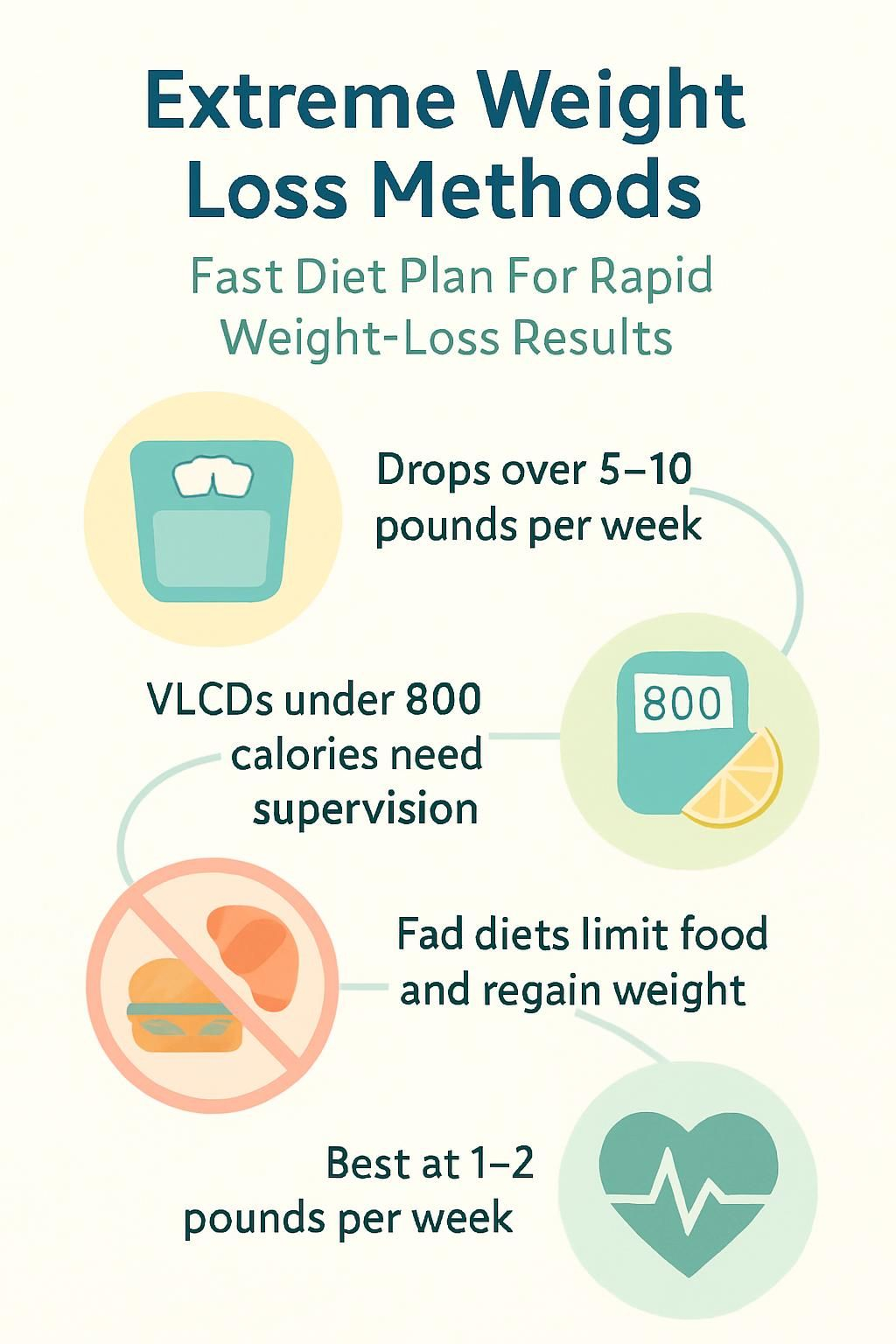Extreme Weight Loss Methods: Fast Diet Plan For Rapid Weight-Loss Results
Our Nutrition Assistant AI Suite will transform your body. You will lose fat, get toned, and build muscle. Gain confidence and optimal health.
If you want to lose weight quickly and feel stuck, you are not alone. Rapid weight loss can happen with very low-calorie diets or strict fasting plans, but these choices carry real risks. This guide explains how fast diet plans work, what the science says, and how to aim for safer results. Use it to decide what fits your life and your health before making big changes. This article is for education, not medical advice.
Key Takeaways
- Extreme weight loss methods, such as very low-calorie diets, can drop 5 to 10 pounds per week at first, but raise risks for nutrient gaps, muscle loss, and heart problems, according to the American Heart Association.
- Fad diets, including keto, paleo, and intermittent fasting, can show changes within days, yet they often cut whole food groups and are hard to keep up, which raises the odds of regaining weight.
- Medical supervision is advised for plans under 800 calories per day. The NIH reports that self-guided extreme dieting can worsen chronic conditions and slow metabolism.
- Better results come from tracking protein, carbs, fats, and key vitamins, drinking water before meals, and checking with a dietitian or healthcare provider first.
- For most people, steady weight loss of 1 to 2 pounds per week works best. Balanced meals, activity, and clear milestones match CDC guidance.

Definition of extreme weight loss
Extreme weight loss means losing a large amount of body weight in a short time. Many experts flag losses of more than 10 pounds in a few weeks, or more than 1 to 2 pounds per week for several weeks in a row.
These methods often use strict calorie cuts, hard limits on food groups, or time-based eating windows. People try them for quick results before an event or to address problems linked with obesity, such as high blood pressure or diabetes.
Fast change can look exciting on the scale, yet it can bring health problems if done without guidance. Knowing why these plans appeal, and what they risk, helps you choose smarter options.
Importance of understanding risks and consulting a healthcare professional
Clear limits protect your health. Very low-calorie diets and fad plans can affect your metabolism, which is how your body burns energy, and may create more harm than good.
Rapid weight loss increases the chance of low vitamins and minerals, muscle loss, heart strain, kidney issues, and swings in blood pressure. A healthcare professional can check your medical history and help match your calorie and carb needs with safe activity levels.
Quick fixes rarely lead to lasting change; advice from a healthcare professional supports steady progress while protecting your health.
With expert support, you can reduce side effects and avoid surprises from sudden dietary shifts. A short visit up front can prevent bigger problems later.
The Appeal and Risks of Extreme Weight Loss

Fast results feel motivating, yet quick paths often carry hidden costs. Think of it as sprinting while carrying a heavy backpack.
Comparison to traditional weight loss
Rapid methods and traditional approaches differ in speed, staying power, and health impact. Use this table to compare the two options.
| Aspect | Extreme Weight Loss Methods | Traditional Weight Loss |
|---|---|---|
| Speed of Results | Rapid, often 5 to 10 lbs per week early on with VLCDs or meal replacements Changes can appear within days | Gradual, about 1 to 2 lbs per week Visible results may take weeks or months |
| Calorie Intake | Severe restriction, often below 800 to 1200 kcal per day | Moderate deficit, usually 500 to 1000 kcal per day below maintenance |
| Sustainability | Difficult to keep long term Higher chance of regaining weight | More sustainable Builds healthy habits over time |
| Muscle vs Fat Loss | Greater risk of muscle loss Early water loss is common | Aims for fat loss while keeping muscle Supports steady body changes |
| Health Risks | Higher risk of nutrient gaps, gallstones, heart strain, and slower metabolism | Lower risk of problems Encourages balanced nutrition |
| Psychological Impact | Can trigger irritability, mood shifts, food fixation, or disordered eating | Supports a better relationship with food Builds a long-term mindset |
| Medical Supervision | Often recommended due to higher risks | Usually not required for healthy adults |
| Popular Examples | Very low-calorie diets, meal replacements, fad diets like keto, paleo, intermittent fasting | Balanced eating, portion control, regular physical activity |
Weigh these trade-offs before you choose speed over staying power. Your long-term health matters more than a quick win.
Potential health risks and psychological impacts
Heavy calorie cuts often cause nutrient deficiencies. Hair loss, brittle nails, or weakness can show that you are not getting enough protein or vitamins. Extreme diets may also slow your metabolism, which makes weight regain more likely once you return to normal meals.
Rapid plans often reduce fat and muscle together. Some people feel anxious, depressed, or obsessed with food when blood sugar swings and strict rules add stress. The American Heart Association notes that repeated cycles of losing and regaining weight, called weight cycling, can affect heart health and self-esteem.
Popular Fast Diet Plans
Many rapid weight loss diets limit calories, cut carbs, or use shakes instead of meals. The plan you pick shapes your energy, hunger, and health.
Fad diets (keto, paleo, intermittent fasting)
Fad diets often promise fast results with simple rules. Here is how the big three work and what to watch for.
- Keto uses very low carbohydrates and high fat to trigger ketosis, a state where your body burns fat for fuel. You may lose quickly, but gaps in vitamins and minerals are common without careful planning.
- Paleo focuses on foods similar to what early humans ate, such as lean meats, fruits, vegetables, and nuts, while avoiding grains, legumes, and dairy. Short-term loss can occur, yet cutting entire groups can reduce fiber and calcium intake.
- Intermittent fasting limits eating to certain hours or certain days. Fewer eating windows can lower total calories and support fat loss.
- Meal replacement shakes sometimes appear with these diets to make calorie control easier. Many lack the fiber found in whole grains and beans, which can change appetite and digestion.
- Skipping whole grains or dairy can reduce calcium and other key nutrients, which may raise the risk of weak bones over time.
- Strict keto raises saturated fat intake. The British Heart Foundation advises monitoring cholesterol and heart risk.
- Because these plans are hard to maintain, weight regain is common once the diet ends.
Check the research behind any plan, and map out how you will meet nutrition needs if food groups are limited.
Meal replacement shakes
Shakes can be a simple tool in a fast diet plan. They control calories and are easy to prepare, but quality matters.
- Pick shakes with at least 15 to 20 grams of protein per serving to help protect muscle during calorie cuts.
- Choose products that include a broad mix of vitamins and minerals to lower deficiency risk while eating fewer calories per day.
- Favor options with more fiber. Fiber supports digestion and helps you feel full.
- Skip blends with lots of added sugar or refined carbs. These can slow weight loss and raise diabetes risk.
- Limit shakes to no more than two meals per day. Keep at least one real meal with fruits and vegetables for variety and nutrients.
- Track blood pressure, weight, and digestion. Some ingredients can cause diarrhea or stomach upset.
- See a healthcare professional first if you have hypertension, heart disease, liver disease, or cancer.
- Pair shakes with activity like strength training or cardio. This helps protect muscle and supports long-term weight control.
- Select brands with evidence from clinical trials or meta-analyses when possible.
For example, one person combined daily walking with two shakes and a high-protein dinner, and dropped 10 pounds in four weeks. Energy was better on days that included a whole-food meal.
Shakes can help with rapid weight loss, yet long-term success still depends on healthy meals and regular movement.
Very low-calorie diets (VLCDs)
VLCDs are different from typical shake plans. They set calories at 800 per day or less and usually require medical oversight.
- Large calorie gaps force the body to use stored fat, called adipose tissue, for energy. This can produce fast loss.
- Doctors may use VLCDs for people with high obesity risk or conditions like sleep apnea, heart disease, or type 2 diabetes.
- VLCDs often rely on special soups, shakes, or bars that supply essential nutrients in small calorie packages.
- Rapid loss can include muscle, not just fat. Losing muscle lowers your metabolic rate and makes maintenance harder.
- Because food variety is limited, watch for nutrient gaps and electrolyte issues. Regular check-ins are important.
- Research shows that without ongoing support and lifestyle changes, most people regain weight after very restrictive diets.
- Side effects can include fatigue, constipation, gallstones, and hormone changes, such as shifts in leptin and insulin, which help control appetite and weight.
- Some people move to bariatric surgery after repeated attempts with extreme diets fail to deliver lasting results.
- Never start a VLCD without speaking to your healthcare provider. Big changes can trigger hidden problems.
- Across long-term studies, a balanced diet plus exercise is safer and more sustainable than very restrictive low-carb plans alone.
The Science Behind Rapid Weight Loss
Rapid weight loss comes from a large calorie deficit and, often, more physical activity. Early drops on the scale can also reflect water changes, not just fat loss.
Calorie deficits and metabolic rates
A calorie deficit means you burn more energy than you eat. Ketogenic diets and VLCDs can cut hundreds, even thousands, of daily calories. That gap drives fast results.
Metabolic rate is how many calories your body burns at rest and during activity. If you cut too deeply, your metabolism can slow. Results may stall, and maintenance gets harder.
Early changes with keto or paleo can look dramatic, especially if you also increase physical activity. Low-density lipoprotein, often called LDL, can drop and high-density lipoprotein, HDL, may improve during early loss for some people.
Severe restriction often leads to fatigue and a slower resting burn rate. Large deficits raise the chance of weight regain once normal eating resumes.
References:
1) Dean Ornish et al., effects on cholesterol, JAMA, 1998. 2) National Institutes of Health, outcomes after severe caloric restriction, 2016.
Effects of hydration on weight loss
Water intake supports weight loss in simple ways. Drinking about 16 ounces before meals can help you eat fewer calories. Hydration also prevents confusing thirst with hunger.
Keto and other low-carb plans use stored glycogen for fuel. Glycogen holds water, so early loss often includes water weight. Aim for pale yellow urine as a quick check that you are hydrated.
Benefits of Extreme Weight Loss
Many people chase quick change to spark hope. A fast start can feel like a strong wind at your back.
Quick results and motivation
Some plans show a 5 to 10 pound drop in week one, especially VLCDs or structured shake programs. Big early wins can lift confidence and help you follow your plan.
Seeing the scale move can make it easier to pass on less healthy foods. Use that momentum to build habits you can keep.
Potential health improvements
Early weight loss can lower blood pressure, ease acid reflux, and improve cholesterol. Better blood sugar control reduces the risk of type 2 diabetes. Joints carry less load as body fat falls, which can improve mobility.
If heart disease risk was high, even a modest loss may reduce that risk factor. Many people sleep better after shedding extra pounds. Cutting highly processed foods can also help skin look clearer.
These gains can come quickly. Still, a healthcare check helps you keep your nutrition balanced while you work the plan.
Increased confidence and self-esteem
As your body changes, confidence often grows. Clothes fit better, and daily tasks feel easier. Social events may feel less stressful once you near your goal weight.
Use this boost to keep building steady habits. Confidence tied to routines lasts longer than confidence tied to the scale alone.
Potential Health Risks
Extreme diet plans can harm both your body and your mind. Use care and lean on evidence before you change how you eat.
Nutrient deficiencies
Plans that cut major food groups often cause nutrient shortfalls. Without enough fruits, vegetables, protein, or whole grains, you can miss iron, calcium, vitamin D, and potassium. Very low-calorie diets raise the risk of anemia and weak bones.
Fatigue, brittle nails, and frequent illness are common signs. A registered dietitian can review your plan and suggest simple fixes, like adding leafy greens or fortified dairy.
Muscle loss
Deep calorie cuts can burn muscle along with fat. Your body will use protein from muscle for energy if food intake is too low. VLCDs and heavy use of meal replacements raise this risk.
Losing muscle slows your metabolism, which makes weight maintenance harder. You may feel weak or tire easily. Studies suggest that 25 percent or more of total loss can come from lean tissue on extreme plans without enough protein or strength training.
Protect your muscle with adequate protein and regular resistance exercise. This keeps your engine running stronger as you lose fat.
Psychological impacts
Strict food rules can increase anxiety and sadness. Rapid shifts in weight may raise the risk of disordered eating, especially for teens and young adults.
Daily weigh-ins and tight calorie targets can become stressful. Social meals may feel awkward if the plan is too rigid. If mood drops or eating feels out of control, seek help from a clinician trained in eating behaviors.
Healthy Alternatives for Sustainable Weight Loss
Lasting change comes from steady steps. Think of these shifts as skills you practice, not punishments you endure.
Balanced diet strategies
A balanced diet supports weight management and general health. Simple choices at each meal add up over time.
- Build meals with fruits, vegetables, lean proteins, whole grains, and low-fat dairy. These foods are nutrient dense and lower in calories.
- Create a moderate calorie deficit. The CDC suggests 500 to 1000 fewer calories per day for many adults.
- Include protein every meal to help protect muscle. Chicken breast, fish, tofu, eggs, or beans all work well.
- Watch portions. Smaller plates and measuring tools can help you avoid extra calories.
- Limit added sugars and saturated fats. The American Heart Association recommends keeping added sugars under 25 to 36 grams daily.
- Drink water during the day. Skip soda and sweet drinks to manage hunger and steady energy.
- Plan and prep meals to reduce last-minute fast food choices.
- Pick healthy snacks like yogurt, nuts, or cut vegetables between meals if needed.
- Track intake with a simple app or notebook to identify patterns fast.
- Consult a registered dietitian before trying extreme plans. Tailored guidance keeps you safe and nourished.
These steps build habits you can keep for years, not just for a season.
Incorporating exercise
Food is the base. Movement speeds progress and improves health markers.
- Start with 30 minutes of moderate activity, such as brisk walking, cycling, or swimming, at least five days per week.
- Add resistance training two to three days weekly. Use weights or body weight to protect muscle as you lose.
- Mix cardio and strength to avoid plateaus and boredom.
- Choose consistency over intensity at first to reduce injury risk.
- Track workouts to see progress and stay motivated.
- Layer in daily actions, like taking stairs or short walks after meals.
- Rest when your body signals fatigue. Quality recovery supports better results.
Regular movement paired with a balanced diet supports faster fat loss and better health.
Setting realistic goals
Set targets that match your health status and schedule. Many experts suggest 1 to 2 pounds per week for most people.
Break big goals into small wins. For example, aim for five pounds in a month or add fifteen minutes of walking each day. Tracking these steps keeps motivation strong.
Small, steady goals make fast diet changes feel doable in daily life.
Creating a Fast Diet Plan
A fast diet plan still needs structure. Careful planning helps you move quickly without missing key nutrients.
Tips for meal planning and prepping
Planning saves time and supports your calorie goals. A little prep can prevent last-minute choices that slow progress.
- Shop with a list that fits your plan. Include lean protein, fiber-rich vegetables, and healthy fats.
- Batch-cook and portion meals in containers to limit overeating.
- Use meal replacement shakes or bars if your plan allows them. They simplify calorie control on busy days.
- Cook simple dishes like grilled chicken, steamed broccoli, and brown rice. These are filling and lower in calories.
- Track calories with an app or journal for clear feedback.
- Keep ready-to-eat snacks, such as chopped veggies or single-serve yogurt.
- Drink water before meals to help curb hunger.
- Eat on a schedule to reduce random snacking and support a steady metabolism.
- Adjust week to week based on weight changes and energy levels.
- Use frozen vegetables and pre-washed greens for quick, nutritious meals.
Importance of macro and micronutrient balance
Macros are protein, carbs, and fats. Protein helps protect muscle as you lose fat. Carbs fuel your brain and workouts. Fats help you absorb vitamins A, D, E, and K.
Micronutrients include vitamins and minerals, like iron, calcium, zinc, vitamin C, and B vitamins. Very low-calorie plans and strict food cuts can cause gaps that lead to fatigue or a weaker immune system.
Track both macros and micros. Simple apps can help you spot shortfalls before they cause symptoms.
Sample fast diet meal plan
Breakfast: Greek yogurt with fresh berries and a spoon of chia seeds. Lunch: grilled chicken over mixed greens with cherry tomatoes, cucumber, and balsamic vinegar.
Aim for 300 to 400 calories per meal by pairing lean proteins with non-starchy vegetables. Keep added sugars low.
Dinner: baked salmon or tofu with steamed broccoli and half a cup of quinoa. Snack: carrot sticks or a small apple if you need energy between meals.
Prepping these meals in advance makes it easier to hit your calorie targets during busy days. A clear plan reduces guesswork and stress.
Monitoring Progress and Adjusting Your Plan
Track key numbers and adjust based on what your body tells you. Small changes, made early, keep you moving forward.
Tracking weight loss and health metrics
Weigh yourself at the same time each week for consistent data. Measure your waist and hips to catch changes that the scale can miss.
Use a notebook or app to log weight, blood pressure, energy, and mood. Trends over weeks matter more than day-to-day swings.
If muscle drops too fast or energy dips, add protein or adjust calories slightly. Data helps you fine-tune your plan safely.
Knowing when to adjust your diet plan
Make changes if progress stalls for two weeks or you feel constantly tired. Sudden hair loss, headaches, trouble focusing, or mood swings can signal nutrient shortages.
Blood tests showing low iron or potassium also point to a need for change. Persistent hunger after meals may mean you need more protein or fiber. Muscle weakness suggests you are cutting calories too much.
Summary: Fast methods require close attention. Use symptoms and lab results to guide smart adjustments, and seek clinical support when needed.
Pay attention to early warning signs. Safe tweaks now protect your long-term health.
Importance of patience and consistency
Changes take time to show up. Your body may need several weeks to reflect new habits in the numbers you track.
People who lose 1 to 2 pounds per week are more likely to keep it off, according to the CDC. Meal prep, hydration, and regular movement, repeated day after day, build lasting success.
Conclusion
You can make progress quickly and still protect your health. Choose speed with care and focus on habits you can keep.
Recap of key points
Extreme plans like VLCDs and heavy use of meal replacements can deliver rapid weight loss. They also raise the risks of nutrient gaps, muscle loss, and mood changes.
Fad diets limit certain foods and are hard to maintain. Safe plans balance protein, carbs, and fats, and include fruits and vegetables.
Track results, watch for warning signs, and set goals you can reach. If possible, work with a clinician or registered dietitian.
Encouragement to prioritize health over quick fixes
Balanced eating and regular exercise support long-term weight control better than most extreme diets. Losing 1 to 2 pounds per week is safer for many people and easier to maintain.
Skipping meals or cutting entire food groups can leave you drained and moody. Building small, steady habits keeps your energy and protects your bones, heart, and mind.
Final thoughts on finding a balanced approach to weight loss
Think speed plus safety, not speed alone. Nutrient-rich foods, steady activity, and realistic goals create results that last.
Track progress weekly and adjust with care. Sustainable habits help you keep the weight off long after any fast diet plan ends.
FAQs
1. What are extreme weight loss methods and do they work for rapid results?
Extreme weight loss methods include very low-calorie diets, liquid meal replacements, and fasting plans. These approaches can lead to fast weight reduction in the short term. Clinical studies show that most people regain lost pounds after stopping these strict routines.
2. Are fast diet plans safe for everyone seeking rapid weight-loss results?
Fast diet plans often lack key nutrients like vitamins, minerals, or protein. Medical experts warn that such diets may cause fatigue, muscle loss, or heart problems if used without supervision from a healthcare provider.
3. How much weight can someone lose with an extreme plan compared to a balanced approach?
Research shows that people on very restrictive diets might lose 5 to 10 pounds in one week; however, most of this is water and lean tissue rather than fat. Balanced eating patterns support steady fat reduction while helping maintain muscle mass over time.
4. Can personal experience help guide choices about rapid diet strategies?
Personal stories reveal mixed outcomes with quick-fix programs; some individuals report initial success but struggle with hunger or energy drops later on. Many find it easier to keep off extra pounds by choosing gradual changes supported by evidence-based advice from nutrition professionals.
Summary: Extreme methods may offer quick changes but carry health risks and rarely provide lasting benefits according to scientific data and real-life accounts alike.
Sources: National Institutes of Health (NIH), Academy of Nutrition and Dietetics







